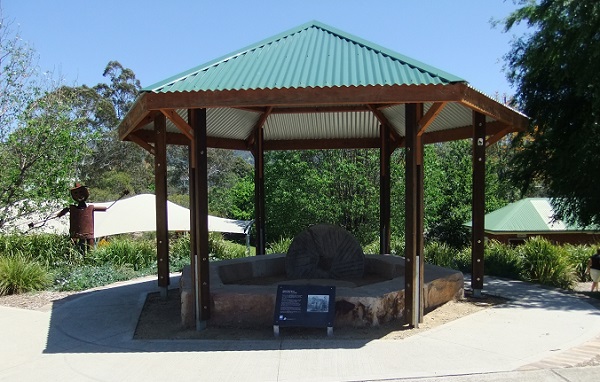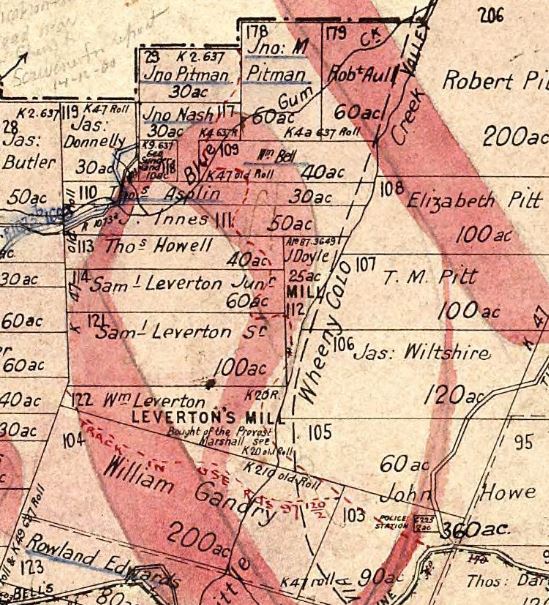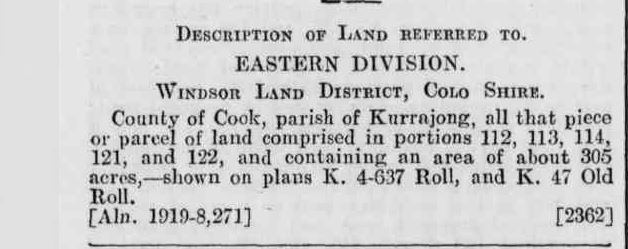Hawkesbury People & Places
Singletons Reserve
Reserve
Singletons Reserve located at 154 Mill Road, Kurrajong, New South Wales was gazetted by the NSW Geographical Names Board in September 2012. The name commemorates the construction and operation of two water-powered grain mills by Benjamin Singleton on Little Wheeny Creek, Kurrajong. There are no known sketches or photographs of either mill or any of the associated buildings or machinery.
Excerpt from Parish of Kurrajong County of Cook map 1893. There may have been two water mills operating on Little Wheeny Creek, Kurrajong by 1821. The face of the map indicates an approximate location of each.
In March1816 a mill, possibly the upper mill known as “Speedwell” was advertised for sale in the Sydney Gazette and NSW Advertiser.
a complete Overshot WATER MILL, and 100 Acres of good LAND, known by the name of the Kurrajong Brush, distant from Windsor about 9 miles, where there is a constant supply of water, the Mill being built on the Winney [sic] Creek, by which said Farm is bounded on the eastward, and on the westward by the Mountains, from the situation of which there is an excellent run for cattle.— The Mill will be engaged to be capable of grinding 40 bushels of wheat daily, and from there being no Mill within a considerable distance, it will have constant work.
The lower mill known as the “Wellington” was listed in the Old Register No 8 in May 1821, however, the date of construction is not known. In a memorial to the Colonial Secretary the previous year, Samuel Leverton jnr stated that he was renting the mill at Kurrajong “lately constructed by Benjamin Singleton”. This may have indeed been the lower mill as Leverton’s name is noted on Portion 114 near to Little Wheeny Creek.
In October 1823, surveyor Robert Hoddle accompanied by a small party which included Archibald Bell passed through Little Wheeny Creek on their journey to mark and survey the route of the road over the mountains to Hartley which was to become known as Bells Line of Road. Hoddle wrote in his report about the thickness of the scrub in the vicinity of the mill.
We had much difficulty to force our way through the thick and prickly Brush which every way abounded for several miles. In some places we were obliged to alter our course, as it was impossible to penetrate, particularly near a Mill in the Kerijjong [Kurrajong] Brush. Diamond Ridge was very narrow, not exceeding a chain in width and Ravines on both sides.
The mills were unable to be sold and were leased to John Town of Richmond until about 1819. Benjamin Singleton was in debt and his real estate assets were sold off by the Provost Marshall in 1821. The holding then became the property of William Leverton until his death in 1824. Passing through the hands of several owners, the property became the property of John Town in 1835 and upon his death in 1846, passed to his wife Mary Town and then to the trustees of his estate.
Adjoining Singleton’s grant on the southern side was a 200 acre grant to William Littleton Gaudry (misspelt Gandry on the face of the parish map). Gaudry arrived in the colony of NSW in 1807 aboard the stores ship Young William. The ship carried a small number of paying passengers including Archibald Bell, his wife and seven children and Gaudry aged 29. Nine years later at the age of only 37 years Gaudry died and was buried at St Matthew’s Cemetery, Windsor.
Early in 1888, George Albert Cleeve decided to purchase the mill property of 305 acres for just over £3,000 on Little Wheeny Creek from Andrew Town, Charles William Lawson, Mary Hale Lawson, William Hillier Holborrow, James Richard Hill, William Charles Hill, The Honourable William Alexander Long, George Hill, who were all trustees of the will of John Town. The parcel included Thomas Howell’s 40 acres (Portion 113), Samuel Leverton’s (junior) 60 acres (Portion 114), Samuel Leverton’s (senior) 100 acres (Portion 121), and 50 acres ascribed to Benjamin Singleton but now marked Samuel Leverton (Portion 122) and a 10-acre portion of the 25 acre grant promised to James Doyle (Portion 112).
The conveyance document from the trustees to G A Cleeve (Old Systems Book 487 Number 225) stated that the ten acre portion which had been promised to James Doyle included “the remains of an old mill” which was named in the document as the Wellington Mill. He quickly set about planting a productive orchard and took on employees to assist him in the task. Cleeve passed away in August 1888 and his death notice stated that his residence was “The Mill” Kurrajong. After the death of George Cleeve, Mrs Cleeve moved the family to Sydney and the mill house and property were leased out.
On the 17 May 1902 the Windsor and Richmond Gazette reported that the house rented by Mr Poole on the property known as “The Old Mill” had been destroyed by fire and noted that John Town had operated a grain mill at this location many years ago. In the next edition on the 24 May 1902 the newspaper went on to say that “This house is not entirely consumed, but it is much injured, and it will cost a good deal to repair it”.
NSW Government Gazette. 31 October 1919, p. 5969. https://trove.nla.gov.au/newspaper/article/227337742
In November 1916, a Primary Application (17628) was completed by members of the Cleeve family which brought the Old Systems Title for the property under the NSW Real Property Act and a new Certificate of Title, Volume 2717 Folio 153 was issued to the owners. The Primary Application sketch noted the location of the remains of the Lower Mill on part of John Doyle’s 25 acres. In October 1919, a notice of resumption for the property of about 305 acres comprising Portions 112, 113, 114, 121 and 122 of the Parish of Kurrajong County of Cook for the settlement of returned soldiers was published in the NSW Government Gazette. The Cleeve family received compensation amounting to £8 per acre.
Following the resumption of the property, the boundaries of the parcel were redrawn and Crown Plans prepared for each of the new portions now numbered 277, 279, 285 and 286. Portion 277 on which the upper mill site was situated and the location of the remains of a stone house nearby. It seems the mill house was not repaired following the fire of 1902. Portion 285 comprising 56 acres was occupied by former soldier Andrew (Andy) Lavender from 1929 on which he established an orchard but his efforts were hampered by the aspect of the land which was prone to severe frosts. The trees produced very little fruit and unfortunately Lavender had to forfeit the property and the land was revoked in 1933. The block was then returned to the property of the Crown.
Over the intervening almost one hundred years, Portion 285 has had a variety of uses including a Reserve for Public Recreation and Camping and for about 40 years from the early 1940s to the late 1970s part of this property was a rubbish tip for the Shire of Colo. The tip eventually covered at least 8-10 acres from Mill Road across to the embankment of Little Wheeny Creek. The Federation of Police Citizens Boys Club was given permissive occupancy for grazing purposes in 1953. Portion 286 of 25 acres was not allotted for Soldier Settlement and is now part of Singletons Reserve.
The Singleton Watermills Archaeological Site (and movable heritage) has been listed on the NSW State Heritage Inventory as a place of state significance. The reserve possibly contains surviving elements of the mill race on the western bank of the creek. Two round stones from the mills were found along the creek, one of them reportedly unearthed by workmen constructing piers for a bridge prior to November 1922. The weathered stones are displayed in the park in the centre of the village of Kurrajong. The site of the stone mill house near the bridge over Wheeny Creek was obliterated when the road was realigned many years later cutting through the small hill on which it once stood.

The two millstones on display in Kurrajong village adjacent to Memorial Park. Cathy McHardy October 2016.
Read the Conservation Management Strategy prepared for Hawkesbury City Council in September 2017 - Singletons Reserve
Singleton Water Mills Archaeological Site (and moveable heritage) is historically important as possibly the earliest example of water mills servicing the needs of colonial Sydney and NSW. The site has potential to reveal even more information regarding local Aboriginal culture, the development of water milling in the Hawkesbury, and the development of associated trade and travel routes of the region.
Read more about Benjamin Singleton and also the establishment of his water mill on the Hawkesbury River downstream from Wisemans Ferry at Singletons Mill
Location of Singletons Reserve
Categories for Singletons Reserve
Related Locations of Singletons Reserve
People Related to Singletons Reserve
You are welcome to add a comment, provide further information or suggest a correction, relevant to the history of this name.
Please make your comment below. PLEASE NOTE that comments are moderated and only relevant comments will be published
Property Research Service
Have you ever wondered when your house was built or who has owned your property over the years?


